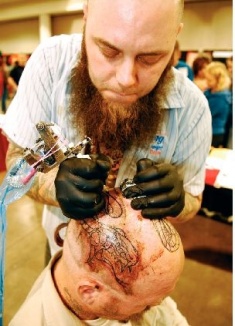I have already written about QR code tattoos before on this blog, so again, I will keep this brief. The video above shows the latest QR code tattoo to gain public attention, this time for generating random .gifs, tweets, and videos. I find these tattoos fascinating because of the way the flesh is made to transmit digital information (“LONG LIVE THE NEW FLESH?!”), in essence augmenting the human body with digitally-encoded information (or are we augmenting the digital with the corporeal?). But many have found these trends disheartening (D’Costa 2012), in part because of the permanence of such body markings.
In a culture that is fast approaching lightspeed (both technologically and culturally), many see the permanence afforded by tattoos and other body modifications as attractive. For many enthusiasts, tattoos have become a source of stability in the postmodern era, a way for individuals to “ground” their identities in an era of whirlwind change (Oksanen and Turtiainen 2005; Sweetman 1999). more...







